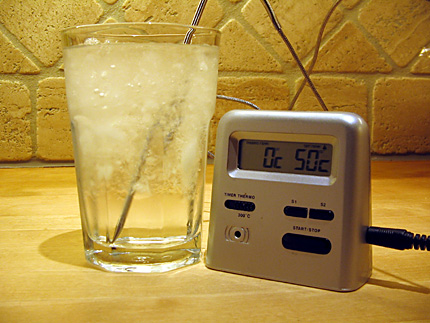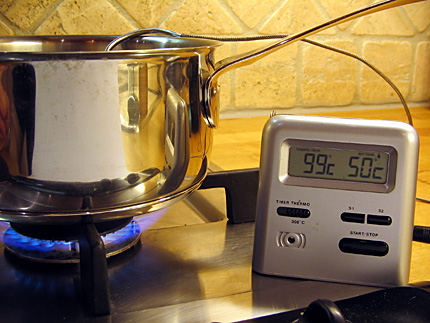2. Know what temperature you’re cooking at.
A dip probe thermometer with a digital read out is a cheap way to bring science into your kitchen. It should preferably cover the temperatures from -30 to 300 °C (-22 to 570 °F). It’s a good idea to check how accurate it is. This is easily done using a water/ice mixture and boiling water.

Fill a glas with crushed icecubes and top of with cold tap water. Leave if for some minutes for the water to cool and stir every now and then. Make sure the tip of the probe does not come in direct contact with ice. A mixture of water and ice is exactly 0 °C (32 °F). If the reading is off by 2 °C (~4 °F) or more I would take the thermometer back to the shop and claim a refund.

Similarly, you can use boiling water as a high temperature reference point. Water boils at 100 °C (212 °F) at sea level and standard barometric pressure. The exact boiling point at your location can be calculated.
When I bought my first thermometer it turned out that the temperature readings were quite erratic so I had to return it. The one I have now however works fine (1 degree off for the boiling water is OK).
As an addition to a dip probe thermometer, contact-less thermometers with infrared sensors are becomming more affordable. Suppliers include Raytek, Strathwood, Radiant and Extech Instruments.
*
Check out my previous blogpost for an overview of the tips for practical molecular gastronomy. The collection of books (favorite, molecular gastronomy, aroma/taste, reference/technique, food chemistry) and links (webresources, people/chefs/blogs, institutions, articles, audio/video) at khymos.org might also be of interest.

Love the tips! And the best part is knowing that there are EIGHT MORE to come!!!
[…] Although I recommend the use of a thermometer, sometimes it’s convenient to know how you can also manage without. If you mix water at two different (but known) temperatures, you can easily calculate the temperature after mixing. Just multiply the temperature of each part with the relative amount. For example, if you have 3 dL at 100 °C and 7 dL at 10 °C (which happens to be the approximate temperature of my tap water), this gives (3 dL x 100 °C + 7 dL x 10 °C) / 10 dL = 37 °C which is just perfect for dissolving fresh yeast when making bread. […]
[…] een post van Khymos.org staat goed beschreven hoe je dit kan testen. Bij mij kwam het water uiteindelijk uit op ruim 98 °C […]